
We are celebrating 15 years — and counting — of stories that are deeply researched and deeply felt, that build a historical record of what the city has been.
We are celebrating 15 years — and counting — of stories that are deeply researched and deeply felt, that build a historical record of what the city has been.
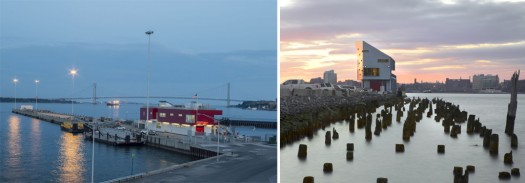
Left: Marine Company 9. Photo by Paul Warchol, courtesy of Sage and Coombe Architects | Right: Marine Company 1. Photo by John Muggenborg, courtesy of CR Studio
Last October, the Fire Department of the City of New York (FDNY) opened a new 8,500-square-foot facility designed by CR Studio on the brand new, purpose-built Pier 53 on the Hudson. It is home to Marine Company 1 and its brand new fireboat, the Three Forty Three. In May of this year, a second marine firehouse, 9,500 square feet and designed by Sage and Coombe Architects, opened in northeastern Staten Island, home to Marine Company 9 and another state-of-the-art fireboat, the Fire Fighter II. The appearance of these two elegant buildings – the only waterfront firehouses in the city – prompted us to dig a little deeper into the story of the FDNY’s Marine Operations unit, its unique architectural needs, cultural significance and essential function as part of the complex system of services that keeps the city safe.
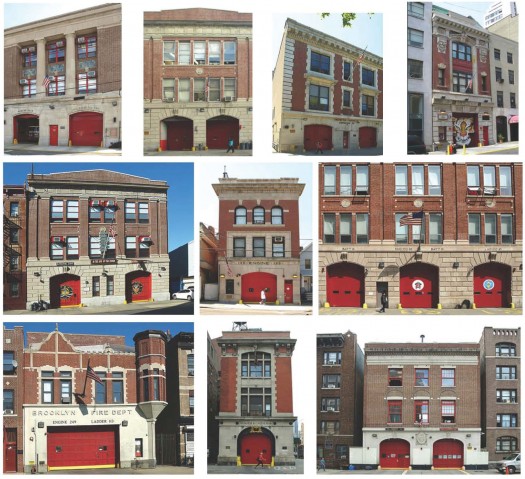
A composite of several traditional New York City firehouses | Courtesy of Sage and Coombe Architects
The Firehouse
The designs of many of the types of buildings that house essential city services – the school, the police station, the hospital, the courthouse – have changed to adapt to technological, cultural or procedural shifts over the years. The design of the classic New York firehouse, however, has endured. The Fire Department built many of its most iconic stations, especially in Manhattan and Brooklyn, during the rapid population increases of the 1880s and 1890s, when the fire engine was horse-drawn and the notion of a full-time, salaried corps of firefighters in the public service was still new. Yet many of the original facilities are still in use, and subsequent FDNY firehouses have often drawn on the design and layout of their predecessors. These compact urban stations accommodate living quarters and offices for firefighters, storage and maintenance for fire trucks and equipment, and, of course, the most efficient way for getting between the two in an emergency: the fireman’s pole.
Throughout its history, traditional firehouse design has accommodated big changes in how urban fires are fought and in the kinds of vehicles that convey firefighting apparatus. But in a city of islands and waterways, not all fire engines travel by road, and not all fires break out along streets. Just a year after the FDNY was professionalized in 1865, the Metropolitan Board of Fire Commissioners saw the need for a “floating engine to fight fires on and along the river fronts” and established a marine unit. At first the unit chartered a steam salvage tugboat for waterfront firefighting, but by 1875 had its very own fireboat built, The William F. Havemeyer, stationed at North River Pier 1 near the Battery.
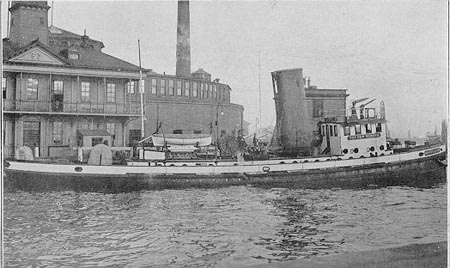
In 1891 fireboat New Yorker is placed in service at Battery Park seawall. At the time, she was the most powerful fireboat ever built and would remain the flagship of the fleet for many years.
FDNY Marine Operations
In the years since, FDNY Marine Operations has responded to emergencies including “boats in distress, people in the water, medical emergencies and injuries in the water or on other vessels, coastal fires, boat fires, and mutual aid to surrounding communities in New Jersey, Long Island and Westchester,” and generally protecting New York City’s 560 miles of waterfront. It has adapted not only to changes in firefighting technology but also to changes to the waterfront itself: an evolution from primarily industrial to increasingly residential, recreational and commercial uses, alongside a resurgent role in the regional transportation network. Throughout, the Marine Companies have been a constant, if under-recognized, presence in the harbor, a battalion of firefighters that, according to Fire Commissioner Salvatore J. Cassano, “take over where the streets of our city end, rescuing people in the water and helping fight fires from angles often not reachable on land.”
The unit’s vital importance to the safety of New York was most dramatically demonstrated on September 11th, 2001. Frank Dwyer, a spokesperson for the FDNY, explains that “following the collapse of the towers at the World Trade Center, the infrastructure which the FDNY uses to put water on a fire was compromised. The only water we were able to get to fight the fires still burning came from our fleet of fireboats. The Department spent the last decade upgrading our fleet of fireboats, and needed new firehouses that could handle these new boats and responsibilities.” Thus, the need for facilities worthy of these exceptional watercraft. The Three Forty Three, named in honor of the 343 firefighters who lost their lives on 9/11, is the world’s largest fireboat, able to travel at 18 knots. It replaces the John D McKean, which had been in service for 54 years. The Fire Fighter II replaces an even older fireboat, the 72-year old Fire Fighter. Both new ships are able to pump 50,000 gallons of water per minute (that’s more than a fire truck can pump by a factor of 50), and both are able to protect firefighters from chemical, biological, radiological and nuclear agents.
These fireboats are like road-based fire trucks in many ways: both types of fire engine are personnel carriers, toolboxes and water tankers in one. But while the parking, maintenance and rapid deployment of the fire truck determines much of the design of the traditional urban firehouse, the marine firehouse has to contend with a different set of constraints related to its vessel, such as mooring, wave attenuation and all of the particular challenges of maritime construction. Nonetheless, Jennifer Sage and Peter Coombe drew inspiration from traditional firehouses for their firm’s design for Marine 9’s new facility in Staten Island.
Marine Company 9
The program for a marine firehouse, according to Sage, “is not that different [from a traditional firehouse] except that you don’t have a truck. And the Fire Department ended up asking us to put in a garage anyway because it’s so much a part of how they work and think. Plus, they always need a workshop.” Marine Company 9’s garage, with its instantly recognizable red door, anchors the “apparatus floor” where equipment is stored and maintained as well as a large kitchen and lounge. Above are the living quarters, gym and offices. After all, the needs of the firefighters extend beyond operational considerations. Sage continues:
“Like all firehouses, it’s a real house. The small group of six or eight people who are on shift at any one time live there half the week; they cook there; it’s very domestic in many ways. But it also has this public face. So it’s a complicated program because it has a very private face and very public face, particularly out on the pier. Response time is important. They need to be able to slide down the pole, run out of the building and onto the boat. There were a lot of sequences that had to be considered. Usually the firefighters go down the pole and hop directly onto the truck; here we are adding a step. They have to get out and down onto the boat.”
Sage and Coombe first came to the attention of the Fire Department when the firm worked on the design for a firehouse renovation in Woodside, Queens. That project was later shelved, but the firm established a good working rapport with the FDNY and was subsequently invited to participate in a competition to design the new Marine 9 facility at the site of the former Navy Homeport. The Economic Development Corporation (NYCEDC) is currently redeveloping this 35-acre decommissioned military base into a new, mixed-use neighborhood dubbed the New Stapleton Waterfront. So, like a traditional firehouse, Marine 9 will be in the midst of a neighborhood (though a nearby, inland firehouse will respond to local fire emergencies). And it really is conceived as part of the overall development of New Stapleton: its design takes into account EDC’s masterplan and zoning conditions, including height and siting limitations to preserve a view corridor, and a public right of way along the pier to the north of the firehouse. This pier, the only extant one along this stretch of waterfront, is the launch point for Fleet Week. But besides that annual festivity, both Sage and Coombe felt “that the firehouse needed to have a very public side” where visitors can enter for the occasional public event or tour, where Marine Company 9 can display its banners and commemorative material, where the relationship between the public service that firefighters provide and the communities they protect is apparent.
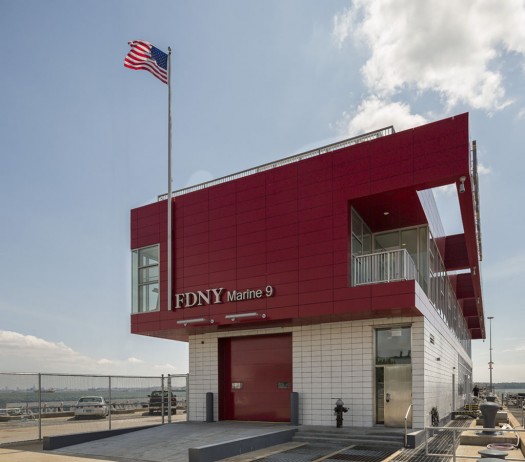
Truck entrance at Marine Company 9’s western (land-facing) facade | Photo by Paul Warchol, courtesy of Sage and Coombe Architects
The architects had to balance this public face with the privacy expected in living quarters, especially in a building exposed on a pier. But they also wanted the fireboat to be visible from within the firehouse. As you enter, you turn and see the boat. And on the second floor, a line of windows along the harborside, south-facing wall helps visually to maintain the intrinsic connection between fire company and fire engine; the fireboat might not be in the garage, but it’s just a few steps away, very much a part of the same architectural system (and, somewhat coincidentally, the firehouse and the fireboat are almost exactly the same size).
The building’s location on top of the pier made the project subject to additional review by the New York State Department of Environmental Conservation (DEC), whose careful scrutiny ensured that the new building and the harbor wouldn’t interfere with aquatic life or the ecosystem. The design also had to ensure that the building wasn’t polluting stormwater runoff as it flows into the harbor. This kind of precondition, in addition to the FDNY’s commitment to sustainability as well as Sage and Coombe’s own interest in green architecture, inspired some of the facility’s green elements, such as the planted roof which functions as a large filter system, retaining and cleaning stormwater before it is released into the harbor.
Perhaps surprisingly, DEC had to be convinced that the firehouse is a “water-dependent use” and couldn’t fulfill its function just as well if it were built beyond the foot of the pier on land. DEC’s disinclination to allowing buildings on piers that don’t absolutely require it is based on the potential environmental hazard if such a building were abandoned in the future, which becomes less of a concern if the building’s use is proven to be truly water-dependent. During the review process, the crash landing of US Airways Flight 1549 on the Hudson River in January of 2009 helped press the case for keeping the firehouse as close to the fireboat as possible to accelerate response time.
Marine Company 1
The only waterfront firehouse in Manhattan also required a design approach that viewed the fireboat, the firehouse and the pier as a cohesive system. For Marine Company 1’s new facilities, on a forgotten block of the Meatpacking District (the intersection of Bloomfield Street and 13th Avenue!) long dominated by Department of Sanitation facilities, CR Studio led a design team that essentially had to construct a pier from scratch and run all of the mechanical systems for the firehouse and its equipment through the pier. CR Studio also has prior experience with the FDNY through DDC’s Design Excellence initiative, working on renovation plans for Hook and Ladder Company 8’s firehouse, probably the most famous firehouse in the city since its star turn in the 1984 movie Ghostbusters.
The sleek, zinc-clad new home for Marine Company 1 replaces a dilapidated, wooden firehouse that, despite historic significance as the last building of its kind on the water, could not feasibly be renovated to accommodate the Three Forty Three or contemporary flood projections. In order for the building to withstand a hundred-year flood, most of the mechanical systems for the building had to be as high above the waterline as possible, and still able to function if the building is cut off from the city grid by a storm or other emergency, so CR Studio tucked them underneath the roof. And yet, as with Marine 9, new buildings are forbidden from casting shadows on the water. According to Jon Dreyfous, CR Studio’s partner in charge of this project, the infrastructural requirements played a large part in determining the profile of the building, which “from the Manhattan side is a very simple shed shape” with the standard red garage door at the pier level that the FDNY can drive a truck through. This shape, however, “transforms towards the water; it gets eroded, peeled and opened up, so that the western façade is very different from the eastern façade.” In fact, Dreyfous refers to the building’s roof as its primary façade, visible from the High Line and elsewhere in the city. As such, it reverses the visual hierarchy of the traditional firehouse, where the formal language of the entry level – the cast stone or limestone base with the red garage door beneath upper storeys of brick – is what communicates, architecturally and urbanistically, the specific function of these iconic buildings.
That familiar set of architectural signifiers is what firefighters are accustomed to, but Marine Company 1 professes to like its new, modern digs. Dreyfous reports that the most important aspect of the design to its users, besides its functionality, was the distinctiveness of the different kinds of space within the building: for equipment, for the workshop, for fitness, for socializing, for being indoors or outdoors, for being quiet, for sleeping. And in a building with this many constraints on its massing and envelope, CR Studio chose to stack those programs -— apparatus floor, shared floor, private floor, infrastructure floor – on top of each other. One preference particular to firefighters, Dreyfous notes, relates to their irregular work hours: since they never know when exactly they’ll be able to catch some sleep, maximizing natural light in sleeping areas is not a priority. The areas where the breathtaking Hudson views are an advantage, such as the fitness area or the lounge, leads to a handsome, asymmetrical window pattern, and a series of angled or protruding exterior walls on the southwest of the building capture light reflecting off of the river.
While a highway stands between this building and its adjacent neighborhood, the bold formal statement the firehouse makes will not just be an elegant curiosity viewed from West Side condos. The site, and the surrounding Gansevoort Peninsula, are very much a part of Hudson River Park. The Hudson River Park Trust, which was the client for the project alongside the FDNY, owns the site and envisions the promontory as “a large green oasis, complete with the Park’s only beach, following the departure of the Department of Sanitation in 2014.” So, like Marine Company 9, Marine Company 1 not only serves as a living reminder of all the City does to protect the waterfront, it actually forms an architecturally constituent element of how New York has re-imagined that waterfront, whether for a new coastal neighborhood in Staten Island or reclaimed open space on Manhattan’s West Side.
Civic Architecture
When the Fire Department launched its expansive building program in the late 19th century, the symbolic impact of its architecture was not taken lightly. The professional force was new, and the Fire Department was eager to announce a strong and recognizable presence in the built environment of New York (which consisted of only Manhattan and the Bronx between 1874 and 1898). The aesthetic commonly associated with urban, mid-block firehouses can be attributed, according to the Landmarks Preservation Commission, in large part to the firm of Napoleon LeBrun & Sons, which “helped to define the Fire Department’s expression of civic architecture, both functionally and symbolically, in more than forty buildings” during an era in which “it was often the practice of architects working for the city to adapt the same design for different locations, as an economical and rapid means of creating public buildings that also clearly identified their civic function.”
Marine Companies 1 and 9 are very different looking buildings, with important similarities: innovative application of green features; the resolution of complex pier, harbor and wave dynamics; the balance of public and private activity. They also share in a kind of symbolism: both signify the Fire Department’s commitment to announcing the essential services it provides through investment in design that prioritizes community, functionality, sustainability and elegance. Perhaps that is their most important contribution to an evolving tradition of municipal and civic architecture. –C.S.
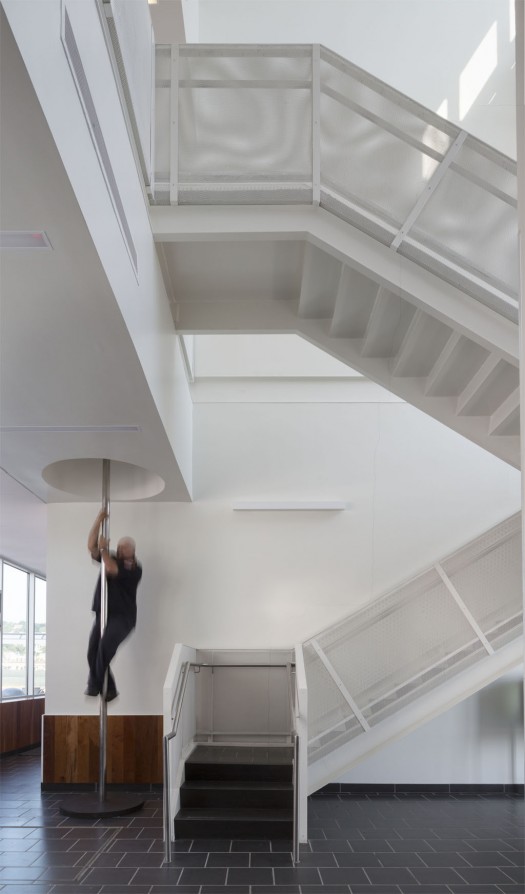
The fireman’s pole at Marine Company 9 | Photo: Paul Warchol, courtesy of Sage and Coombe Architects
Homepage image, clockwise from top left: Marine Company 9, photo: Paul Warchol, courtesy of Sage and Coombe Architects; Marine Company 1, photo: John Muggenborg, courtesy of CR Studio; Ribbon-cutting at Marine Company 9; courtesy of the FDNY; the Three Forty Three performing a watershow, courtesy of the FDNY.
The views expressed here are those of the authors only and do not reflect the position of The Architectural League of New York.
Comments